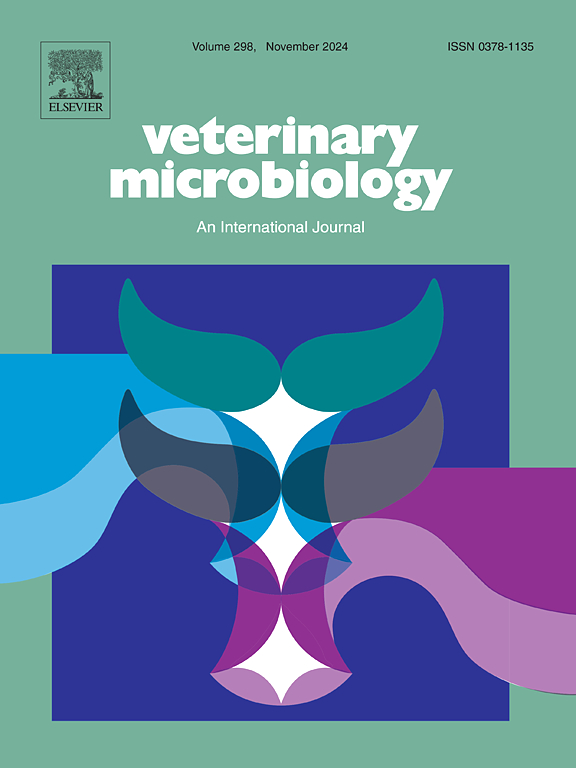猪肺炎支原体气溶胶感染模型的特征描述
IF 2.4
2区 农林科学
Q3 MICROBIOLOGY
引用次数: 0
摘要
本研究的目的是开发一种猪肺炎支原体(M. hyopneumoniae)感染和呼吸道疾病的气溶胶实验模型并确定其特征。实验旨在确定肺炎支原体剂量控制气溶胶的致病性、定植、粘膜免疫反应和临床病程。四组不含肺炎双球菌的后备母猪,每组三只,在一个试验室内分别接触含有肺炎双球菌 232 株的稀释肺匀浆气溶胶。每组暴露于不同剂量的活生物体(105 至 106 个变色单位/毫升,连续两天,15 至 20 分钟或 30 至 35 分钟)。在暴露后 0、7、14、21 和 28 天(dpe)收集每只后备母猪的鼻、喉和气管深部分泌物。在接触后 0 天和 28 天采集血液样本。尸体解剖时,对肺部病变进行评估,并收集每组肺的支气管分泌物和支气管肺泡灌洗液(BALF)。血液通过间接酶联免疫吸附试验(ELISA)来评估血清转换,而支气管肺泡灌洗液、气管深部和鼻腔分泌物则通过修改酶联免疫吸附试验(ELISA)来评估粘膜 IgG 和 IgA 的产生。鼻腔、喉部、气管深部和支气管分泌物通过实时 PCR 检测来评估细菌量。所有后备母猪在7 dpe时的气管深部分泌物中都检测到了肺炎双球菌,因此无论感染剂量大小,后备母猪都会受到感染。从 14 日龄开始,所有后备母猪都出现了特异性局部体液免疫反应。虽然所有实验组的后备母猪都出现了一定程度的支原体肺炎,但只有接触高剂量气溶胶的后备母猪能持续再现典型的临床症状和严重的肺部病变。这些结果表明,通过传染性气溶胶可以成功地在实验水平上再现支原体肺炎,从而使该模型成为评估针对肺炎霉形体的预防和治疗措施的一种有价值的替代方法。本文章由计算机程序翻译,如有差异,请以英文原文为准。
Characterization of a Mycoplasma hyopneumoniae aerosol infection model in pigs
The purpose of the present study was to develop and characterize an experimental aerosol model for Mycoplasma hyopneumoniae (M. hyopneumoniae) infection and respiratory disease in pigs. The experiment was carried out to determine the pathogenicity, colonization, mucosal immune response, and clinical course of disease of dose-controlled aerosols of M. hyopneumoniae. Four groups of three M. hyopneumoniae-free gilts each were individually exposed to aerosols of diluted lung homogenate containing M. hyopneumoniae strain 232 in a chamber. Each group was exposed to different doses of viable organisms (105 to 106 color changing units/mL during 15–20 or 30–35 min in two consecutive days). Nasal, laryngeal, and deep-tracheal secretions were collected from each gilt at 0, 7, 14, 21, and 28 days post-exposure (dpe). Blood samples were collected at 0 and 28 dpe. At necropsy, lung lesions were assessed, and bronchial secretions and bronchoalveolar lavage fluid (BALF) were collected from each lung set. Blood was used to assess seroconversion by means of an indirect ELISA, while BALF, deep-tracheal and nasal secretions were tested by modifying the ELISA to evaluate mucosal IgG and IgA production. Nasal, laryngeal, deep-tracheal, and bronchial secretions were tested by real-time PCR to evaluate bacterial load. Gilts became infected irrespective of the infectious dose, as determined by M. hyopneumoniae detection in deep-tracheal secretions from all gilts at 7 dpe. A specific local humoral immune response starting at 14 dpe was detected in all gilts. While all experimental groups presented gilts with some extent of mycoplasmal pneumonia, only the exposure of gilts to high-dose aerosols consistently reproduced typical clinical signs and severe lung lesions. These results showed that the reproduction of mycoplasmal pneumonia by means of infectious aerosols can be successfully achieved at experimental level, making this model a valuable alternative to evaluate preventive and treatment measures against M. hyopneumoniae.
求助全文
通过发布文献求助,成功后即可免费获取论文全文。
去求助
来源期刊

Veterinary microbiology
农林科学-兽医学
CiteScore
5.90
自引率
6.10%
发文量
221
审稿时长
52 days
期刊介绍:
Veterinary Microbiology is concerned with microbial (bacterial, fungal, viral) diseases of domesticated vertebrate animals (livestock, companion animals, fur-bearing animals, game, poultry, fish) that supply food, other useful products or companionship. In addition, Microbial diseases of wild animals living in captivity, or as members of the feral fauna will also be considered if the infections are of interest because of their interrelation with humans (zoonoses) and/or domestic animals. Studies of antimicrobial resistance are also included, provided that the results represent a substantial advance in knowledge. Authors are strongly encouraged to read - prior to submission - the Editorials (''Scope or cope'' and ''Scope or cope II'') published previously in the journal. The Editors reserve the right to suggest submission to another journal for those papers which they feel would be more appropriate for consideration by that journal.
Original research papers of high quality and novelty on aspects of control, host response, molecular biology, pathogenesis, prevention, and treatment of microbial diseases of animals are published. Papers dealing primarily with immunology, epidemiology, molecular biology and antiviral or microbial agents will only be considered if they demonstrate a clear impact on a disease. Papers focusing solely on diagnostic techniques (such as another PCR protocol or ELISA) will not be published - focus should be on a microorganism and not on a particular technique. Papers only reporting microbial sequences, transcriptomics data, or proteomics data will not be considered unless the results represent a substantial advance in knowledge.
Drug trial papers will be considered if they have general application or significance. Papers on the identification of microorganisms will also be considered, but detailed taxonomic studies do not fall within the scope of the journal. Case reports will not be published, unless they have general application or contain novel aspects. Papers of geographically limited interest, which repeat what had been established elsewhere will not be considered. The readership of the journal is global.
 求助内容:
求助内容: 应助结果提醒方式:
应助结果提醒方式:


